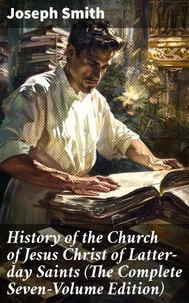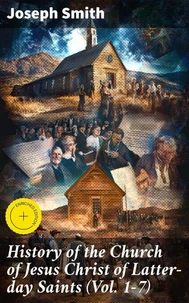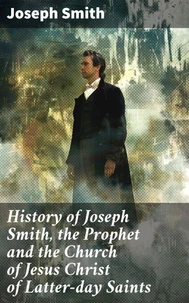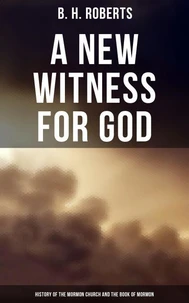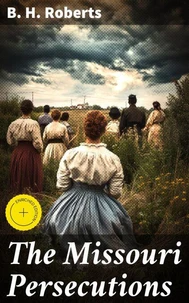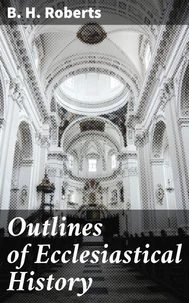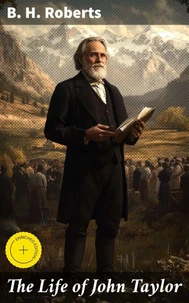Outlines of Ecclesiastical History
Par :Formats :
Disponible dans votre compte client Decitre ou Furet du Nord dès validation de votre commande. Le format ePub est :
- Compatible avec une lecture sur My Vivlio (smartphone, tablette, ordinateur)
- Compatible avec une lecture sur liseuses Vivlio
- Pour les liseuses autres que Vivlio, vous devez utiliser le logiciel Adobe Digital Edition. Non compatible avec la lecture sur les liseuses Kindle, Remarkable et Sony
 , qui est-ce ?
, qui est-ce ?Notre partenaire de plateforme de lecture numérique où vous retrouverez l'ensemble de vos ebooks gratuitement
Pour en savoir plus sur nos ebooks, consultez notre aide en ligne ici
- Nombre de pages382
- FormatePub
- ISBN859-65--4714496-0
- EAN8596547144960
- Date de parution01/08/2022
- Protection num.Digital Watermarking
- Taille759 Ko
- Infos supplémentairesepub
- ÉditeurDIGICAT
Résumé
B. H. Roberts' "Outlines of Ecclesiastical History" is a meticulous examination of the evolution of the Christian Church, exploring its growth, turmoil, and theological debates from its inception through significant historical milestones. Roberts employs a scholarly yet accessible literary style, combining narrative clarity with analytical depth, making this work a vital resource for understanding the intricacies of ecclesiastical developments.
The book is situated within a broader discourse on religious history and is particularly notable for how it addresses the intersection of faith and institutional authority, a theme deeply rooted in the challenges faced by early Christians and their various sects. B. H. Roberts, a prominent figure in early 20th-century Mormon thought, was actively engaged in both theological discourse and historical investigation.
His background in religious studies and his roles within the Latter-day Saint movement undoubtedly informed his perspective on ecclesiastical history. Roberts' dual identity as a historian and theologian allows him to draw upon both scriptural sources and historical documentation, providing a comprehensive overview that is both reverent and critical of its subjects. I wholeheartedly recommend "Outlines of Ecclesiastical History" for readers interested in the complexities of church history and its implications for modern faith.
This work not only serves as a valuable reference but also invites readers to ponder the ongoing relevance of early ecclesiastical struggles in today's religious landscape.
The book is situated within a broader discourse on religious history and is particularly notable for how it addresses the intersection of faith and institutional authority, a theme deeply rooted in the challenges faced by early Christians and their various sects. B. H. Roberts, a prominent figure in early 20th-century Mormon thought, was actively engaged in both theological discourse and historical investigation.
His background in religious studies and his roles within the Latter-day Saint movement undoubtedly informed his perspective on ecclesiastical history. Roberts' dual identity as a historian and theologian allows him to draw upon both scriptural sources and historical documentation, providing a comprehensive overview that is both reverent and critical of its subjects. I wholeheartedly recommend "Outlines of Ecclesiastical History" for readers interested in the complexities of church history and its implications for modern faith.
This work not only serves as a valuable reference but also invites readers to ponder the ongoing relevance of early ecclesiastical struggles in today's religious landscape.
B. H. Roberts' "Outlines of Ecclesiastical History" is a meticulous examination of the evolution of the Christian Church, exploring its growth, turmoil, and theological debates from its inception through significant historical milestones. Roberts employs a scholarly yet accessible literary style, combining narrative clarity with analytical depth, making this work a vital resource for understanding the intricacies of ecclesiastical developments.
The book is situated within a broader discourse on religious history and is particularly notable for how it addresses the intersection of faith and institutional authority, a theme deeply rooted in the challenges faced by early Christians and their various sects. B. H. Roberts, a prominent figure in early 20th-century Mormon thought, was actively engaged in both theological discourse and historical investigation.
His background in religious studies and his roles within the Latter-day Saint movement undoubtedly informed his perspective on ecclesiastical history. Roberts' dual identity as a historian and theologian allows him to draw upon both scriptural sources and historical documentation, providing a comprehensive overview that is both reverent and critical of its subjects. I wholeheartedly recommend "Outlines of Ecclesiastical History" for readers interested in the complexities of church history and its implications for modern faith.
This work not only serves as a valuable reference but also invites readers to ponder the ongoing relevance of early ecclesiastical struggles in today's religious landscape.
The book is situated within a broader discourse on religious history and is particularly notable for how it addresses the intersection of faith and institutional authority, a theme deeply rooted in the challenges faced by early Christians and their various sects. B. H. Roberts, a prominent figure in early 20th-century Mormon thought, was actively engaged in both theological discourse and historical investigation.
His background in religious studies and his roles within the Latter-day Saint movement undoubtedly informed his perspective on ecclesiastical history. Roberts' dual identity as a historian and theologian allows him to draw upon both scriptural sources and historical documentation, providing a comprehensive overview that is both reverent and critical of its subjects. I wholeheartedly recommend "Outlines of Ecclesiastical History" for readers interested in the complexities of church history and its implications for modern faith.
This work not only serves as a valuable reference but also invites readers to ponder the ongoing relevance of early ecclesiastical struggles in today's religious landscape.


